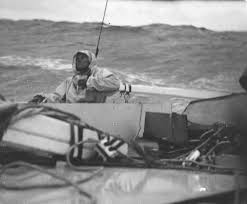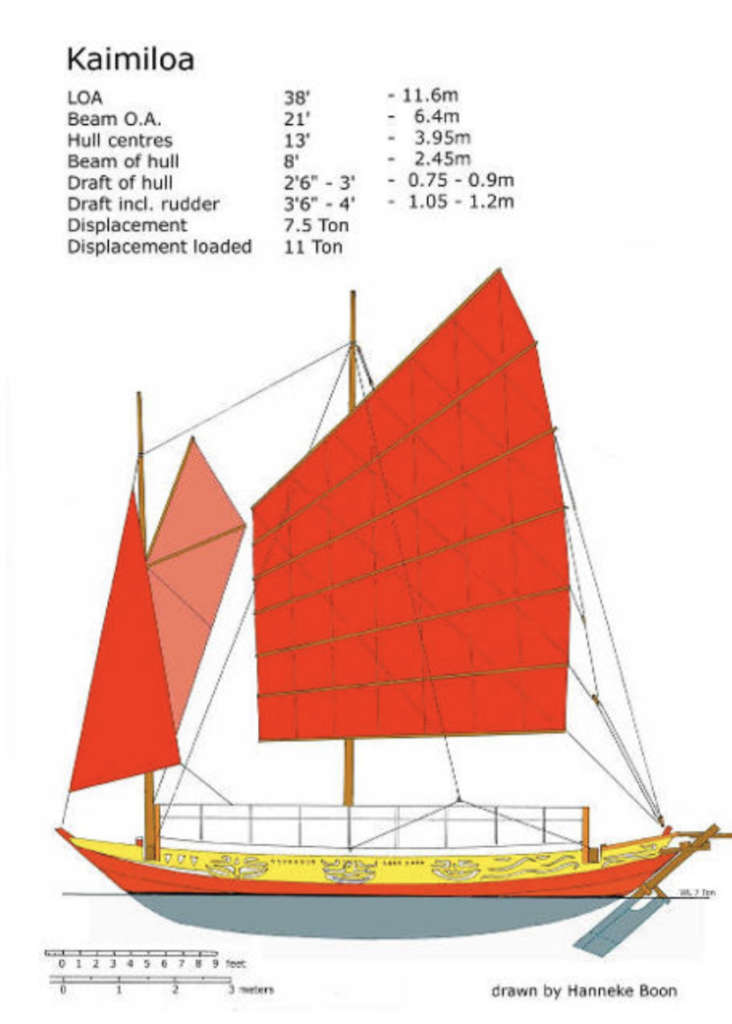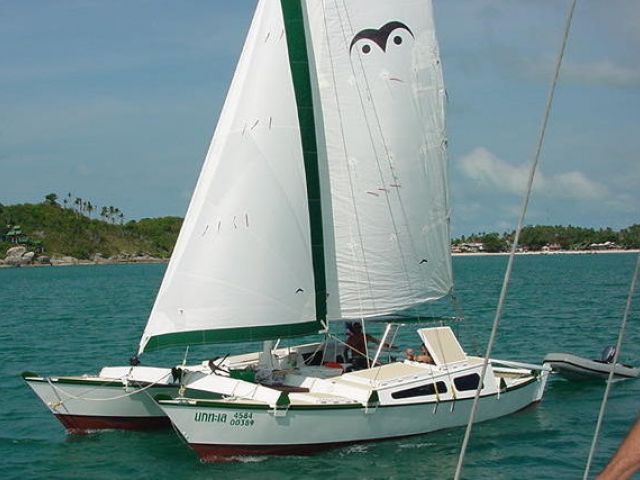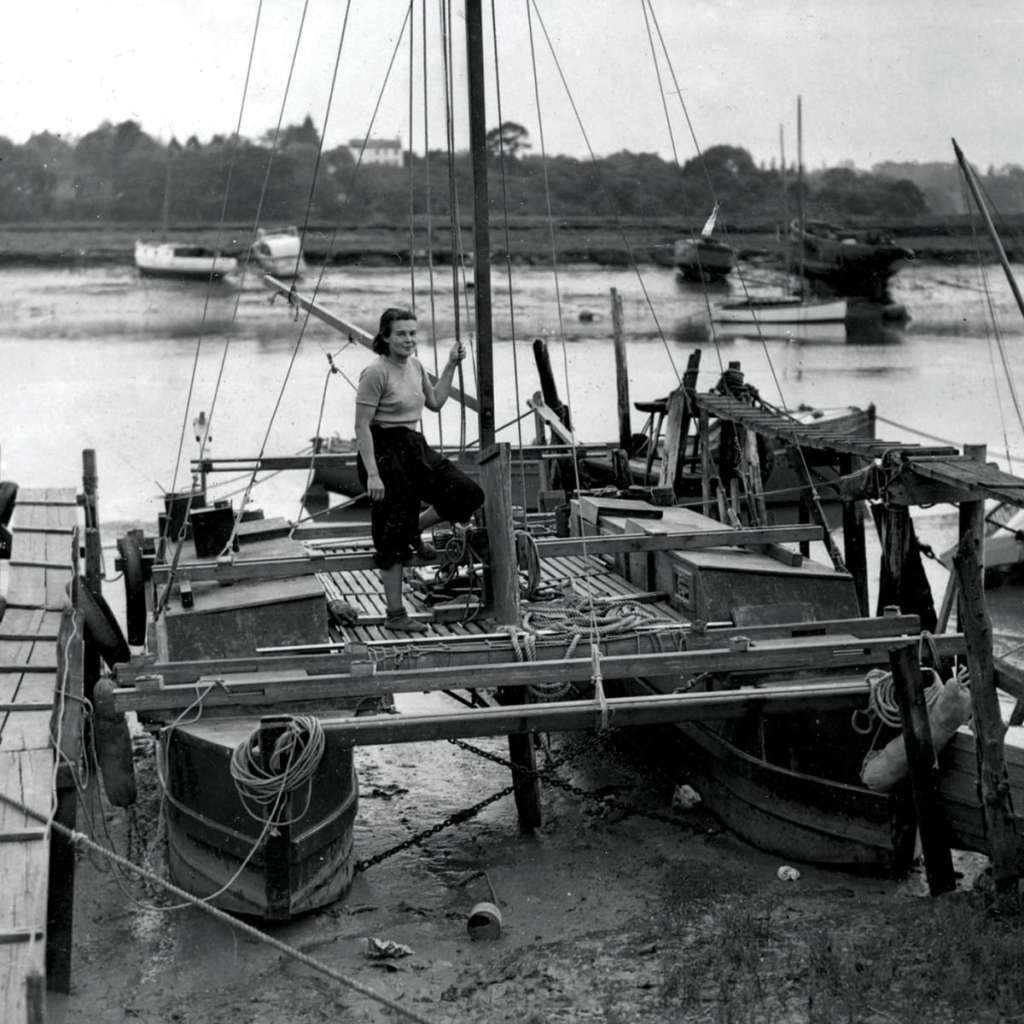
I read that James Wharram the Polynesian self build designer of double hull sailing canoes died in December 2020. He lived to grand age of 92.
James was Working class lad from Manchester who loved the outdoor life and climbing. When he was 16 he read a book at his local Library about a Pacific Ocean French sailor Eric De Bisschop and his friend crewman Tati.
Eric and his friend Taiti initially left mainland China in a small junk rigged boat Fuo Po. They actually lost two boats eventually half staved they landed in Hawaii. Not daunted by their misfortunes they went on to build a canoe doubled hulled Polynesian style catamaran but using junk rig sails. Daily they were visited on the beach by the locals. Normally negative comments; that never cross the pacific, crazy men!
Eric found a young Hawaii girl one day looking seriously at Kaimiloa? Eric said to her “you seem to be in serious contemplation”? She said she liked the look of the catamaran and said the Hawaii spirits will be with them on their voyage across the Pacific. The Hawaiian lady was an indigenous princess who Eric became very fond of during beach construction of Kaimiloa.
After launching Kaimiloa they sailed her back to France via Torrs straight and across the Indian Ocean past South Africa and up the Atlantic into the Mediterranean to France.

Two years ago when I was moored in Carloforte Sardinia I use go out kayaking along the coast of San Pitro from the main harbour.
In one of the small bays there was a James Wharram designed TIkI catamaran at anchor left looking a little forlorn! I think this was a smallish one between 21 and 26 feet long.
On my various sailing Jaunts I’d occasionally come across Wharram catamarans. They’re very like a Polynesian canoe like catamaran, low freeboard and swept up bow and deep vee hulls.
Down below they’re fairly basic with accommodation in each of the canoe shaped hulls. Some have an extra central pod. They seem responsive to sail and are pretty fast only being fairly light displacement.

An article from Sail. More than just a sailor and designer, James Wharram, originally of Manchester, England, is also both a free-thinker and an individual clearly dedicated to getting as much out of this life as possible. Although he made his mark as a multihull designer, builder and voyager who drew inspiration from the ancient catamarans and proas of Polynesia, such a distinction only scratches the surface of his story—as is evident in the tale of how he came to build his very first catamaran in this excerpt from his recently published autobiography, People of the Sea.
Looking back in time, my “I want to” [build and sail a double canoe across the Atlantic] seems ridiculous, a juvenile fantasy. I was 25-years-old, I had no inherited money, no trade, no profession; I was a dreamer. Ruth [Wharram’s then girlfriend and future wife, who passed away in 2013] sat quietly and replied, “I will help you, but only if you put all your best effort and all your abilities into the project.”
Discipline had entered into my life. Then being practical she asked, “How much will it cost?” Around that time there was a small book on sailing by Weston Martyr called The £200 Millionaire, so I quickly said: “Oh about £200,” (£200 in 1954 being approximately equal to £5,500 in 2019, or about $7,500). We sold our Annie E. Evans to two river policemen and returned to England.
On the way back to my parents’ home in Manchester, we stayed in London to visit the Science Museum in south Kensington, with its marvelous collection of Chinese junks and Pacific canoe models. There I found exhibited a model of a 24ft double canoe with a beautiful hull shape made in 1935 by an old Polynesian islander in the Society Islands. I bought a photograph of this model and decided to use this boat as a base for my Polynesian double canoe. At 24ft it could be built within my limited budget.
The hull shape of the model was quite slender, so with this as a starting point I had to redesign the hull shape for loading up with sufficient stores to cross the Atlantic from Britain to the tropical isles of the West Indies, a voyage which would be of similar distance and sea conditions as a long Pacific sea voyage.
A great help in my design research was the Manchester Central Library, which sought out for me a book entitled Canoes of Oceania written by Haddon and Hornell, published in Hawaii in 1936. It was a compendium of all that was known of Pacific canoe-form craft from the past and still in existence in the 1930s, with drawings and descriptions of their construction and sailing observations by the early explorers.
Throughout my wandering years, my father had kept a despairing eye on his disappearing dream of a major Wharram construction firm. Whenever I needed money, he would casually mention that “so and so building firm is setting up a major project.
As a laborer you will be sure to get a job,” and I would always get taken on when I applied. Many years later I realized that he must have “put in a word” to the inner group of building project managers. I also suspect the word was “give him a hard time.” I was always at first given the nasty jobs, but when I would say I was leaving, there was frequently a hanging silence that said I should stay, prospects were there.
The building job that I took to raise the money for my Tangaroa was at the construction site of an office block, where they were making a framework of reinforced concrete floors and pillars to be walled in later. In the mid-1950s concrete was delivered from the mixer to the wooden forms by a large two-wheeled barrow, and as a laborer that was my job.
When they saw that I understood “structure,” I was moved to being a part of the woodworking team that made the forms out of thick plywood to pour the liquid concrete into. I was unaware at the time that I was learning about the strength and possibilities of plywood as an easy-to-use, hardwearing, loadbearing material.
James went on to build a whole range of Catamaran’s from his design office in Cornwall. You can buy plans from him depending upon your budget and Wharram Catamarams are sailing in different parts of the world. The majority are self build from James detailed plans

.

Tehini was built by James and his friends just across the Conwy river at Deganwy across from where Stella Polaris my boat is now moored!

Maybe in future blog posts I’ll pick out interesting sailors ? One who springs to mind is Sir Francis Chichester a wonderful navigator of both the sea and the air. He was an adventurer extraordinary !
What I found most fascinating and admire so much about James and all of the earlier ocean sailors was their sheer resourcefulness. Why? The likes of Joshua Slocomb first man to sail solo around the world who repaired an old sailing boat himself. Harry Pidgeon another round the world sailor who built his own wooden sailing boat and James Wharram who modelled his Polynesian design catamaran his hero French sailor Eric De Bisschop.
Each and everyone of them were strapped for cash. They needed a boat and they just went out and built one in most cases close to where they launched them! In certain cases people helped them. If you have a dream to achieve something in life and your totally focused on your goal to can achieve anything!